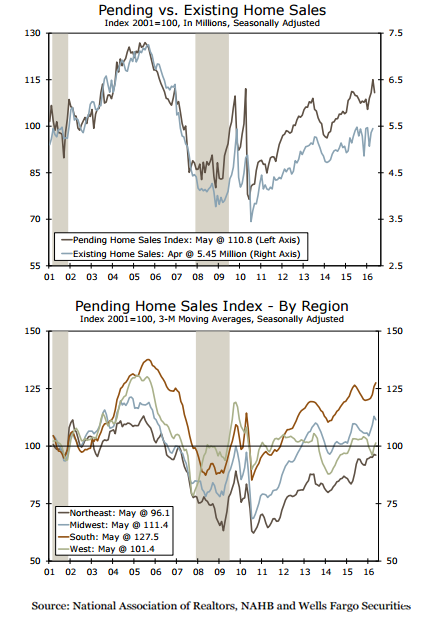Pending home sales hit the skids in May, following three straight months of increases. The National Association of Realtors® (NAR) said that its Pending Home Sales Index (PHSI), a forward looking indicator based on contract signings for home purchases, declined by 3.7 percent from April to 110.8 in May. The May reading is also 0.2 percent below that in May 2015. It was the first time the year-over-year number decreased after 20 straight months of gains that started in August 2014. The April PHSI, originally reported as a 5.1 percent gain was revised down to a 3.9 percent increase.
NAR said all four regions experienced a cutback in contract activity in May and three of the four came in at or below their May 2015 levels.
Analysts surveyed by Econoday had been looking for a slowdown, but not one as severe as reported. The consensus was for the PHSI to decline by 1.0 percent.
Lawrence Yun, NAR chief economist again said tight inventories were part of the problem with sales. He said, "With demand holding firm this spring and homes selling even faster than a year ago, the notable increase in closings in recent months took a dent out of what was available for sale in May and ultimately dragged down contract activity. Realtors® are acknowledging with increasing frequency lately that buyers continue to be frustrated by the tense competition and lack of affordable homes for sale in their market."
Despite mortgage rates hovering around three-year lows for most of the year, Yun says scant supply and swiftly rising home prices - which surpassed their all-time high last month - are creating an availability and affordability crunch that's preventing what should be a more robust pace of sales.
"Total housing inventory at the end of each month has remarkably decreased year-over-year now for an entire year," adds Yun. "There are simply not enough homes coming onto the market to catch up with demand and to keep prices more in line with inflation and wage growth."
The Brexit vote in which the United Kingdom decided to leave the European Market has roiled markets and its fallout could be felt in housing. Yun said the decision "breeds both immediate opportunity as well as potential headwinds for the U.S. housing market."
"In the short term, volatility in the financial markets could very likely lead to even lower mortgage rates and increased demand from foreign buyers looking for a safer place to invest their cash," he said. "On the other hand, any prolonged market angst and further economic uncertainty overseas could negatively impact our economy and end up tempering the overall appetite for homebuying."
In spite of the May slip in contract signings, NAR expects existing-home sales this year will be around 5.44 million, up 3.7 percent from 2015. After accelerating to 6.8 percent a year ago, national median existing-home price growth is forecast to slightly moderate to between 4 and 5 percent.
On a regional basis the PHSI dropped by 5.3 percent in the Northeast to 93.0 in May, and is now unchanged from a year ago. In the Midwest the index slipped 4.2 percent to 108.0 putting it 1.8 percent below May 2015.
Pending home sales in the South declined 3.1 percent to an index of 126.6 but are still 0.6 percent higher than the previous May. The index in the West decreased 3.4 percent in May to 102.6, and is now 0.1 percent below a year ago.
The PHSI is based on pending sales of existing homes. A sale is listed as pending when the contract has been signed but the transaction has not closed, though the sale usually is finalized within one or two months of signing.
The index is based on a large national sample, typically representing about 20 percent of transactions for existing-home sales. An index of 100 is equal to the average level of contract activity during 2001, which was the first year to be examined. By coincidence, the volume of existing-home sales in 2001 fell within the range of 5.0 to 5.5 million, which is considered normal for the current U.S. population.








